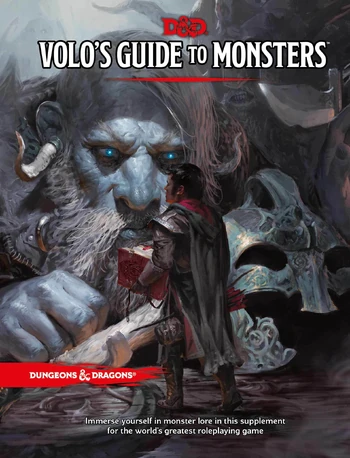 So in what's an interesting break from the previous editions of Dungeons & Dragons, 5th Edition doesn't quite have a bunch of numbered Monster Manuals, and while it did mean that it took me a while of googling the right book to buy in order to find the one with all the cool new monsters, I feel like it does help to give each subsequent bestiary-style books a lot more freedom on what content they have, and also to not overwhelm newer players on going "oh god, there are five parts of the Monster Manual?"
So in what's an interesting break from the previous editions of Dungeons & Dragons, 5th Edition doesn't quite have a bunch of numbered Monster Manuals, and while it did mean that it took me a while of googling the right book to buy in order to find the one with all the cool new monsters, I feel like it does help to give each subsequent bestiary-style books a lot more freedom on what content they have, and also to not overwhelm newer players on going "oh god, there are five parts of the Monster Manual?"Volo's Guide to Monsters is a collection of several monsters published in some other 5th Edition adventures and modules, as well as several new ones. We've covered a couple of the classic updates to some old-time favourites and some forgotten classics in my review of the 1E Monster Manual -- namely the Morkoth, the Slithering Tracker, the Rot Grub Swarm, the Catoblepas, the Leucrotta and the Kirin. Likewise, instead of merely being a bestiary listing some 200+ odd monsters, Volo's actually ends up detailing a bunch of new-for-5E player character races (which we also covered separately), and had aroud half of its pagecount devoted to detailing the societies of some of the more intelligent classic D&D monsters, like Beholders, Kobolds, Gnolls, Orcs, Goblins, Kenku, Drow and Yuan-Ti. I'm not sure what I'm going to do with the lore segments for these -- some of them I've worked into the segments when I reviewed the creatures originally as I went through the Monster Manual, but I'm not sure what I'll do with the rest, whether I'll go through them in a brief addendum later, or if I'll just retroactively add the flavour bits to the segments in previous review series. We'll see.
For now, I'll just go through a chunk of the bestiary that forms the second half of Volo's Guide to Monsters!
- Click here for the previous part, covering the back-end of the Monster Manual, as well as player races from Volo's.
- Click here for the second part of Volo's, covering Girallons to Neothelids.
- Click here for the index.
_____________________________________________________
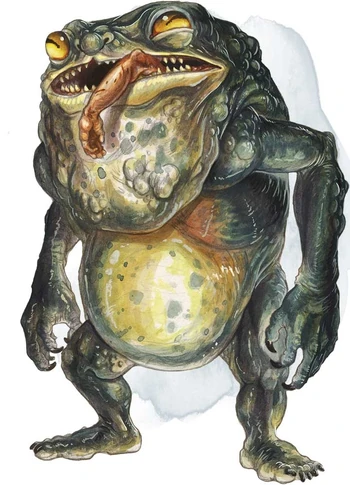

Banderhobb
- 5.5E/5E: Large Monstrosity; Neutral Evil; CR 5
The 5E lore notes that the Banderhobb is created by evil hags (and other evil magic-users who learned how to do so) "from shadow and flesh", and serves its creator as either a thug, thief or kidnapper. A lot of the monsters in Volo's are actually obvious additional minions for some of the highlighted star villains in the book -- hags in this case -- but they do a pretty great job at making sure that each monster still has its own identity that allows them to be used without being tied to said 'star' monster. Despite the frog-like appearance, though, the Banderhobb only shares a single quality with its animal-like inspiration, which is a long tongue and the ability to use said tongue to wrap up and swallow its prey. It's not unintelligent, but it's driven by a drive to track down whoever that its creator has asked it to kill and/or kidnap, going by some very classic flavourful "it only needs a lock of hair to track a prey" deal going on. The prose notes just how surprising the Banderhobb actually is, having great strength despite having spindly arms, and being stealthy despite being a huge frog-ogre thing.


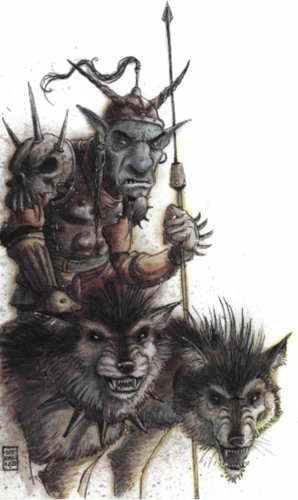
Barghest
- 5.5E/5E: Large Fiend; Neutral Evil; CR 4
5E gave us another interesting wrinkle by telling us the origin of the Barghest, where they were the result of a deal that went sour between the goblin god Maglubiyet and the General of Gehenna, leader of the mercenary Yugoloth fiends. The result of the spat was the creation of the soul-devouring Barghest, created to deny Maglubiyet of souls. See, Barghests are born to goblin parents, just like any goblin children, but will end up reverting to its true form, which is the goblin-faced wolf demon thing, each Barghest driven by an impulse to consume 17 goblin souls (specifically 17 as a reference to some detail in the Maglubiyet/General deal) to deny Maglubiyet said souls in his immortal army. The Barghest is picky about who they kill, picking leaders, and they will often hide and pretend to be a goblin before attacking their prey as opportunity rises. Goblins being goblins, when they discover a Barghest in their tribe, instead of rage they react with basically one-upping each other with "oh no I'm a loser don't eat me". Also, it seems that Barghests can actually devour non-goblinoid souls as long as they are humanoid, and if they do so it's a race against time before the soul is permanently consumed and digested by the barghest. There's a lot of things going on here, for something that could've easily been just "werewolf, but goblin", but I do appreciate them taking the time to essentially craft a unique monster. A huge fan.
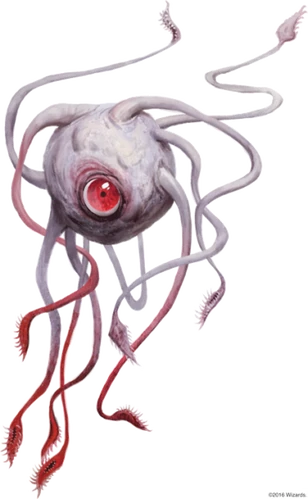
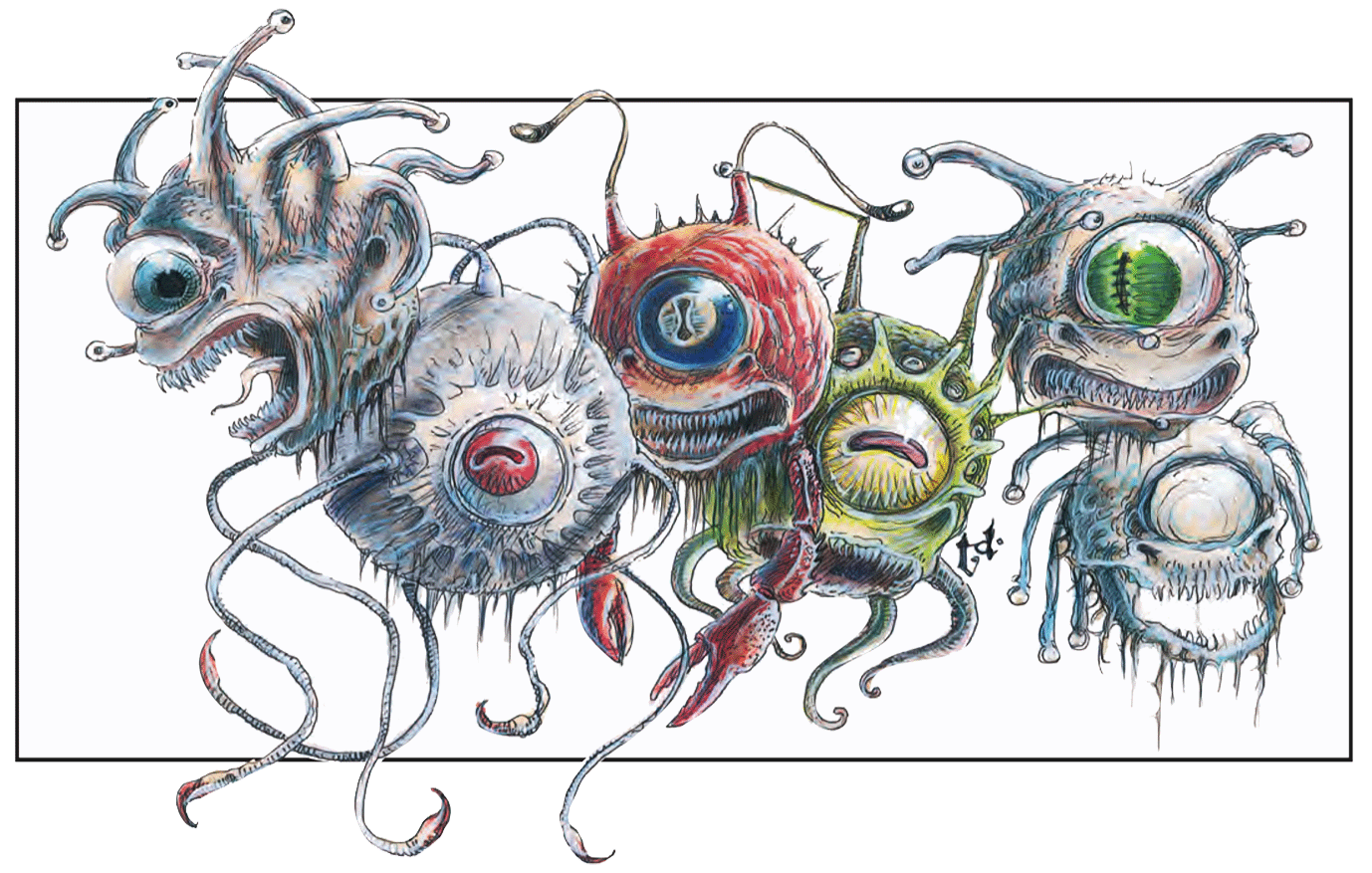
Beholder: Death Kiss
- 5.5E/5E: Large Aberration; Neutral Evil; CR 10
The Death Kiss, the first Beholderkin we cover, is easily one of the most striking Beholder variant, simply having a single red eye, no mouths, and no eyes atop any of its other tentacles. Its tentacles are also far, far more squid-like (although they end in mouths), and the combination of pale white and blood red does make for a very pleasing colour scheme. The Death Kiss is noted to come into being when a Beholder has a nightmare about losing blood, and it's basically a crazy, blood-drinking version of the Beholder. It's obsessed with the dream that spawned it -- losing blood -- and it basically goes around and continues to hoard as much blood as possible, even from little creatures, with its tentacle-mouths. It's intelligent enough to pretend to be a big scary beholder, but ultimately nowhere as much of a paranoid chessmaster as its more iconic cousins. Overall, the Death Kiss is a pretty neat variation, actually feeling so much more like a related variant instead of "Beholder, but weaker". Between the striking visual appearance and the blood-themed flavour, I do like the Death Kiss a lot.

Beholder: Gauth
- 5.5E/5E: Medium Monstrosity; Lawful Evil; CR 6
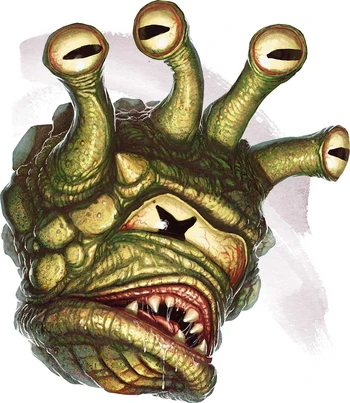
Beholder: Gazer
- 5.5E/5E: Tiny Aberration; Neutral Evil; CR 1/2
Interestingly, Volo's also includes rules for Gazer familiars, and honestly, Gazers are probably far more useful (and hilarious!) than like a raven or a rat or something.
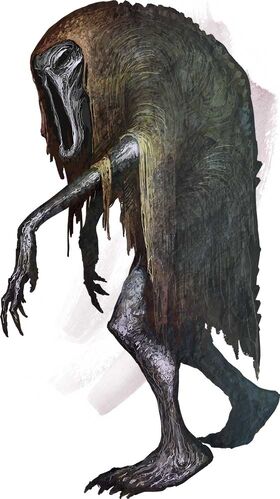
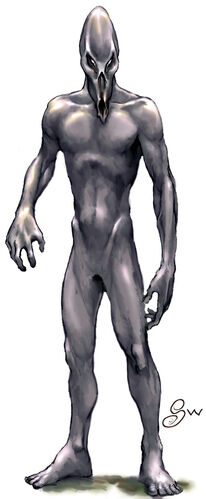
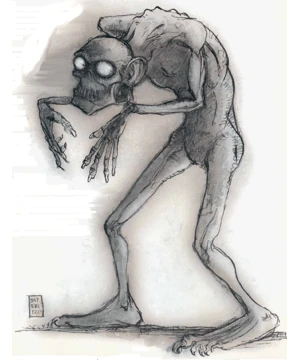
Bodak
- 5.5E/5E: Medium Undead; Chaotic Evil; CR 6
Also, the regular Bodak might be a mere CR 6, but apparently Orcus has a small army of lieutenants, the very first Bodaks to be created that are called the Hierophants of Annihilation, which had the power to raise any corpse it sees into a Bodak. They're also very special to Orcus, who can apparently see and hear and even speak through every single Bodak. It's noted that it's such an unnatural thing that nature itself rejects Bodaks, and that's why the sun burns it and why its mere presence chills everything around it. A neat little explanation for what would otherwise be a generic "evil creature are weak to sunlight" quality.
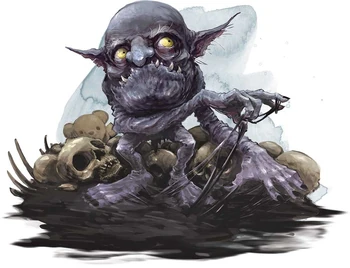

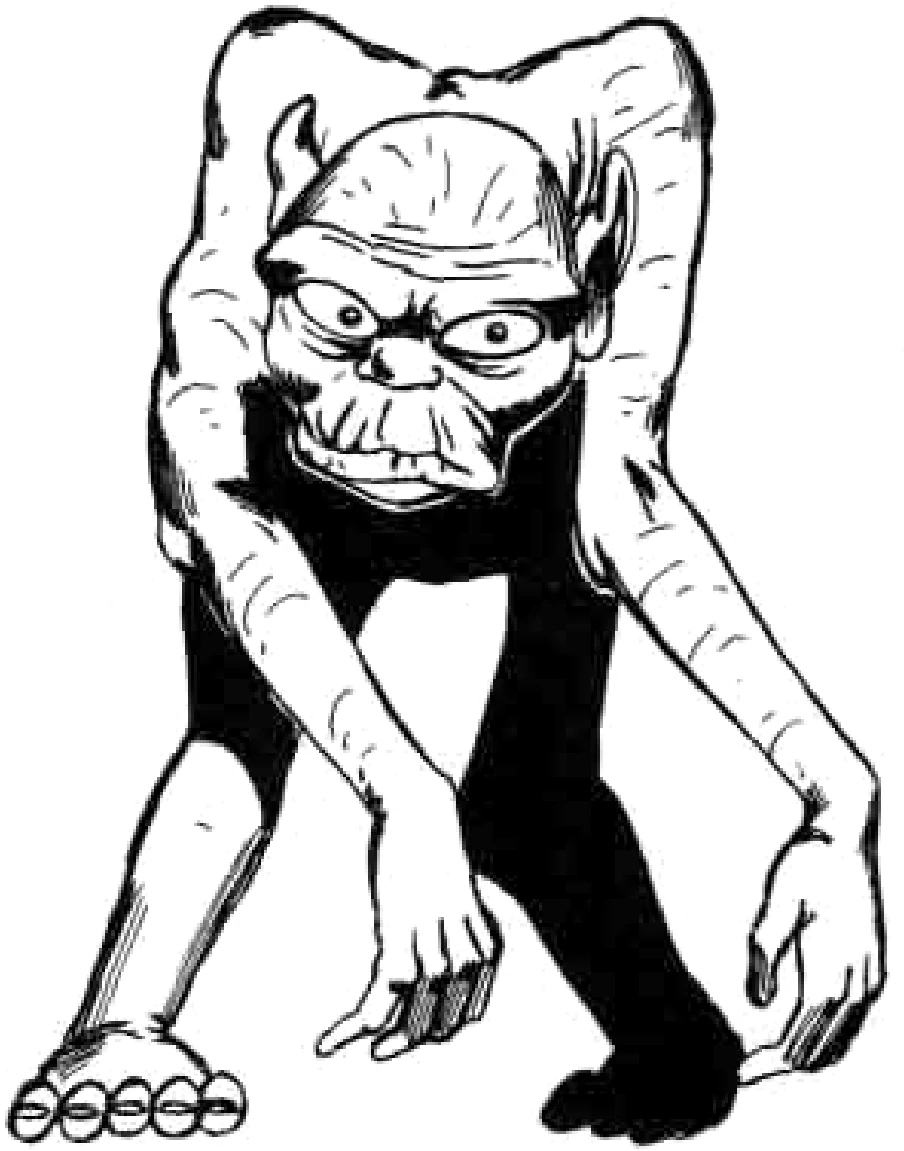
Boggle, a.k.a. Bogey
- 5.5E/5E: Small Fey; Chaotic Neutral; CR 1/8



Catoblepas
- 5.5E/5E: Large Monstrosity; Unaligned; CR 5
5E's Catoblepas, goes back to basics, being a buffalo-like creature with a long neck and a boar's head, and it's noted to be a combination of, and I quote, "bloated buffalo, dinosaur, warthog and hippopotamus", created by a god of pestilence and rot. I'm not sure which part of this creature is a dinosaur, but okay. I guess it's that Ankylosaur-esque tail? And, just like most editions, the Catoblepas's stinky breath is highlighted, as is its necrotic gaze. The Catoblepas blights the land aroud it, but it's noted to not be openly hostile, just territorial... but the fact that it warps the lands around it so badly probably means that your adventuring party will, more likely than not, be asked to murder this beast. Also, apparently hags herd Catoblepas like cattle and drink their milk. Ooookay. We get a lot of description in most editions about how the Catoblepas is noted to be a harbinger of misfortune and bad omens, but 5E's wordings note just how unconfirmed and ambiguous these are. For what it's worth, despite the Catoblepas's effects and buddies mostly being evil creatures, it's always classified as a neutral or unaligned creature in all five editions. A pretty interesting beast, actually, and one that I've tended to overlook for just being a stinky weird cow.


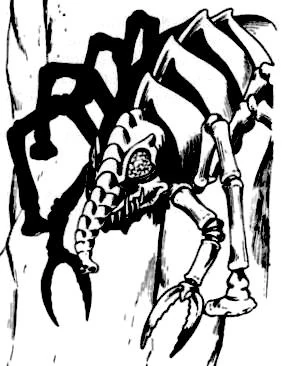
Cave Fisher
- 5.5E/5E: Medium Monstrosity; Unaligned; CR 3

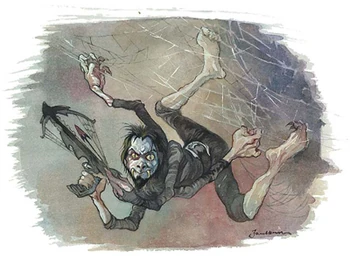

Chitine
- 5.5E/5E: Small Monstrosity; Chaotic Evil; CR 1/2
The Chitines were created out of drow experimentation on captured elves, transforming them into humanoid-spider mutants, and they had intended to create slaves that are dedicated to themselves and Lolth, but apparently Lolth herself found this completely unacceptable. Not because of the fact that human (well, elven) experimentation was being done, but how dare they not dedicate that to Lolth herself. So Lolth ended up twisting the rituals so that the Chitines now serve her, and because Lolth's kind of a dick, she tends to have the Chitines fight the Drow. It's a fun spider-creature! One of the monster races that get a spotlight in Volo's is the Drow, and the Chitines are there to give the Drow some extra, interesting muscle-power because sometimes, Drow still create Chitines and those that aren't exposed to the Choldrith are still relatively obedient.


Choldrith
- 5.5E/5E: Medium Monstrosity; Chaotic Evil; CR 3
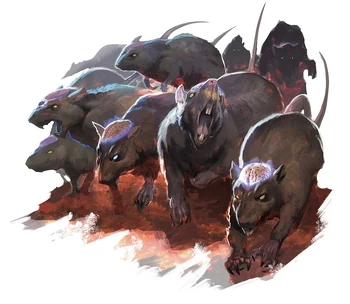
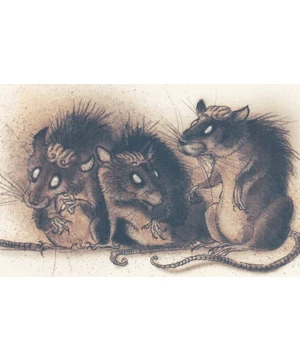
Cranium Rat
- 5.5E/5E: Tiny Beast; Lawful Evil; CR 0
- 5.5E/5E: Medium Swarm of Tiny Beasts; Lawful Evil; CR 5


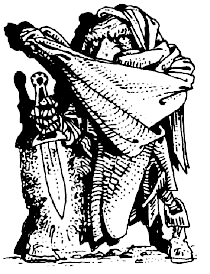
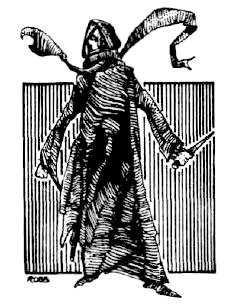
Darkling (Dark Ones)
- 5.5E/5E: Small Fey; Chaotic Neutral; CR 1/2 (Darkling)
- 5.5E/5E: Medium Fey; Chaotic Neutral; CR 2 (Darkling Elder)
And then Volo's Guide to Monsters had "Darkling" as one of the new monsters, a term that's never been used before... and I would've ignored it if the artwork didn't reuse the 3E artwork for the Dark Ones verbatim. The difference, of course, is that the Darklings are now explicitly fey creatures, the descendants of Dubh Catha, a seelie fey who betrayed the archfey Summer Queen, and all of his descendants were forever cursed and transformed into the Darklings, transforming their entire race into assassins. It's the Summer Queen's curse that causes them to be wounded and age rapidly under sunlight, and if they die due to absorbing too much sunlight, they fucking blow up. Darklings also love to hoard art and jewels. The short, stubbish Darklings can undergo a ritual with tattoos to channel the sunlight stored into their body to transform themselves into the Darkling Elder, a form that looks far more like an elf. Ultimately... the Darklings are pretty much a neat revamp of the Dark Ones, although given a lot more backstory, although I'm not quite sure why the rename was necessary. Regardless, Darklings and Dark Ones are pretty neat, if not the most interesting enemies. But, hey, more fey adversaries! These are far more straightforward enemies for fey, mind you, just stabbing you in the chest instead of playing tricks or polymorphing you or whatever.
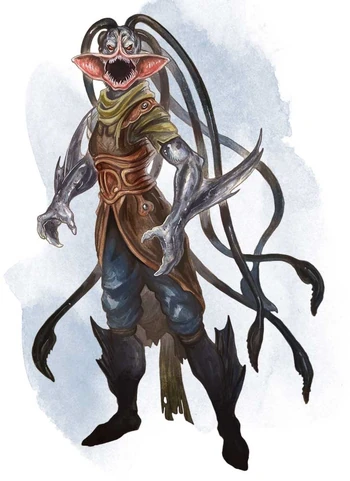
Deep Scion
- 5.5E/5E: Medium Humanoid; Neutral Evil; CR 3
The Deep Scion is technically a humanoid, but man does it really look like it belongs in the aberration category. A monster original to 5th Edition, the Deep Scion really gives me a huge Shadow Over Innsmouth vibe, and I really do love the way this dude's mouth opens wide like a flower (I don't think it's actually based on any real deep-sea creature, although I could be wrong), as do the tentacle-whip ponytails and the fins on its arms. The Deep Scions were created in a pretty Lovecraftian way, too, where they were people who drowned from sinking ships, and were offered by a terrible bargain by something deep underwater. Cthulhu? Davy Jones? N'Zoth? You decide. Volo's suggests the kraken as a possible patron, but also notes that it might be a different ancient being of the deep, so, yeah, feel free to have these things serve your Cthulhu expy of your choice. Whatever the case, they were reborn into this new, creepy, fishy forms. The Deep Scions are shapechangers, though, and they are able to shapeshift into their original human forms to infiltrate society and undergo whatever task its aquatic master wants it to. They infiltrate society and worm themselves in with a specific purpose, giving the outward appearance of a hero returning alive from where he or she drowned, or to generally just charm and beguile their way into society to carry out its master commands, having been stripped of empathy or any attachment to its former life by the transformation into a Scion. Deep Scions are actually not particularly powerful in combat, so they are clearly meant to be an enemy that the DM is meant to use in a more insidious, 'uncover the NPC's plots' way.


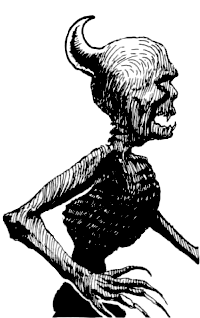
Demons: Babau


Demons: Babau
- 5.5E/5E: Medium Fiend - Demon; Chaotic Evil; CR 4
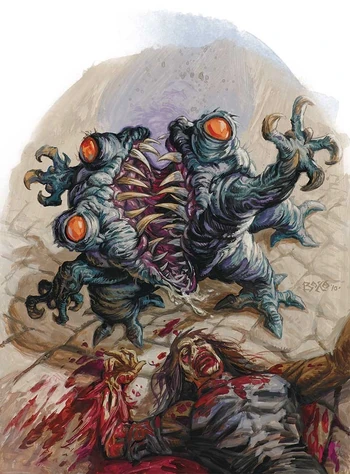
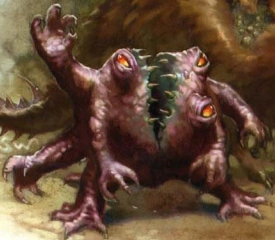
Demons: Maw Demon
- 5.5E/5E: Medium Fiend - Demon; Chaotic Evil; CR 1
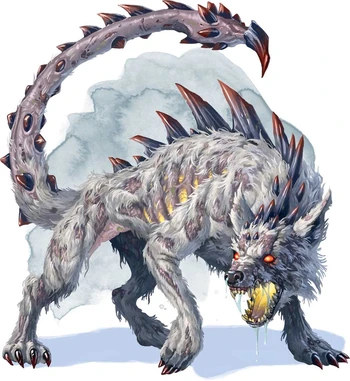
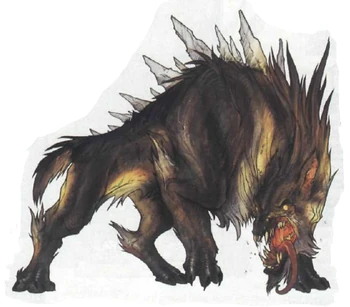
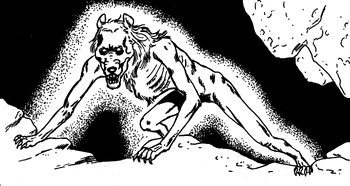
Demons: Shoosuva
- 5.5E/5E: Large Fiend - Demon; Chaotic Evil; CR 8
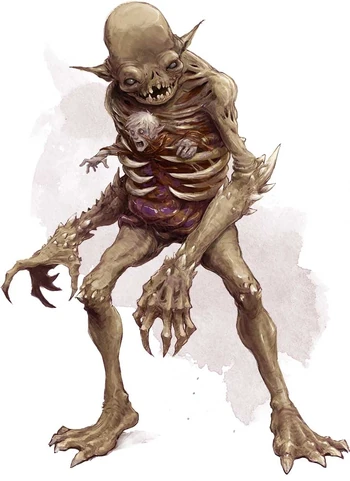


Devourer
- 5.5E/5E: Large Fiend; Chaotic Evil; CR 13


 |
| Draegloth (4E) |
- 5.5E/5E: Large Fiend - Demon; Chaotic Evil; CR 7
Anyway, the Draegloth's pretty damn awesome, and it's noted to be "born of a drow high priestess in an unholy, dangerous ritual" (it's basically Demon Sex but I'm pretty sure they're not allowed to say that outright), and it's always loyal to its mother and her House. The four arms it has allow it to essentially be either rampaging around with the massive claws and muscles of its larger ones, or to do finer things with its Drow-sized arms. Which basically means, yes, it's a powerful melee fighter that can also cast magic. Also, despite being the size of an ogre, the Draegloth is very sneaky. The birth of a Draegloth is noted to be a sign that Lolth has blessed their House, and are essentially noted to be what amounts to a tool to them. They're treated with respect, yes, but they don't really have any sort of standing in their House, and all Draegloths are indoctrinated to accept its role as more of a favoured tool and never to challenge authority. Being, y'know, half-demon half-drow, Drageloths invariably resent this, and this would lead to them going off and being independent sometimes. It's actually a pretty interesting concept -- the Draegloths (and by extension the Glabrezu) does play into the Drow's spider theme by having multiple limbs, but this doesn't really get a whole lot of attention by the prose. Ultimately, a pretty damn awesome spider-demon-creature.
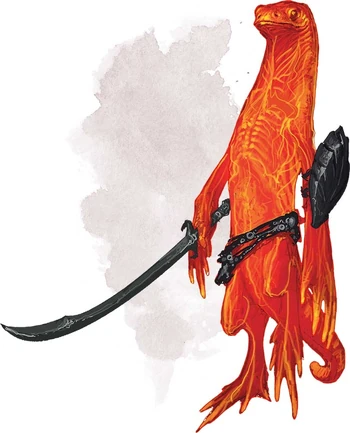


Firenewt
- 5.5E/5E: Medium Humanoid; Neutral Evil; CR 1/2 (Warrior), 1 (Warlock of Imix)

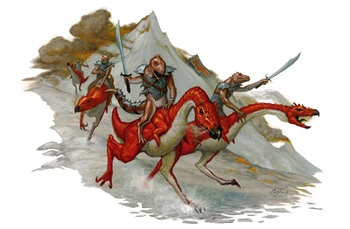

Giant Strider
- 5.5E/5E: Large Monstrosity; Neutral Evil; CR 1 (Giant Strider)
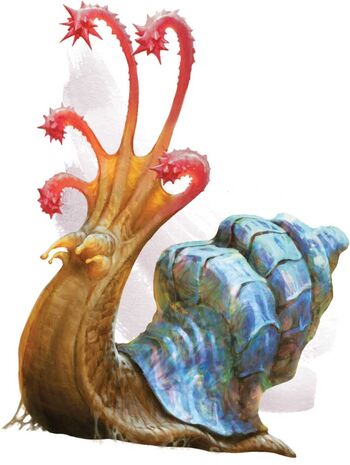
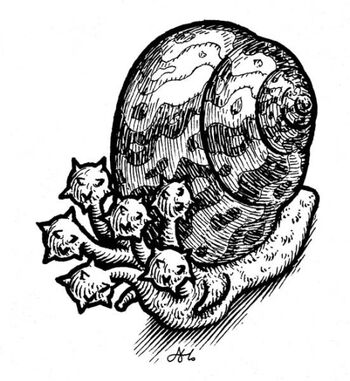
Flail Snail
- 5.5E/5E: Large Elemental; Unaligned; CR 3
5th Edition revamps the Flail Snail as an earth elemental, which is... an interesting direction to take it, I suppose. It's notes to be able to have a batch of tricks beyond just being a snail with flail-tentacles, and has the ability to unleash displays of bright light to stun the enemy, its shell can deflect magic (giving a new meaning to the classic D&D spell 'anti-magic shell') and it consumes everything as it moves path the surface, eating dirt and rocks and leaving behind a trail of glass. Ultimately, while not the most interesting monster, it's just so goofy and such a bizarre creature that I can't help but be a fan of this utterly bizarre creature.
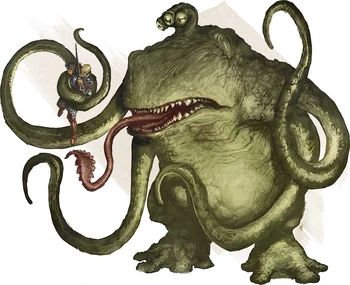
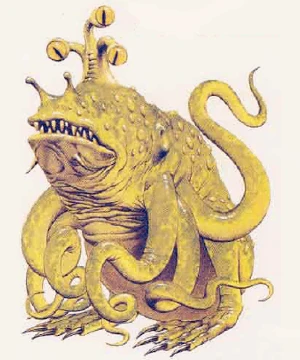
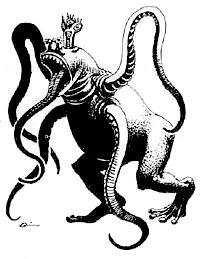
Froghemoth
- 5.5E/5E: Huge Monstrosity; Unaligned; CR 10
The 5th Edition lore just has the Froghemoth as an aberration-type creature, being a massive predator the size of an elephant. Surprisingly enough, 5E even keeps the sci-fi origin story of the Froghemoth, and its prose notes how a mad wizard found them in 'strange, cylindrical chambers of metal' in some underground cave from which the Froghemoths came, and the only real thing that stops them from being outright frog-octopus aliens is that the wizard who gave this report is noted to be mad, and no subsequent editions found the UFO-cave. It's a neat, sneaky and ambiguous enough nod to the origins of the Froghemoth, while the reference to the futuristic cylinders will very well go over the heads of anyone who doesn't quite know about the origins of these creatures in D&D. The Froghemoths are also apparently worshiped by the dumb Bullywugs, although the attempt to appease a Froghemoth might lead to multiple Bullywugs being chowed down as a result.
And here are the other creatures whose 'base' versions we've sort of talked about before in the MM. (Yes, I know gnolls come after girallons, but I'm swapping the order of things up a bit)
Dinosaur
- 5.5E/5E: Tiny Beast; Unaligned; CR 1/4 (Velociraptor)
- 5.5E/5E: Medium Beast; Unaligned; CR 1/4 (Dimetrodon), 1 (Deinonychus)
- 5.5E/5E: Large Beast; Unaligned; CR 1/4 (Hadrosaurus)
- 5.5E/5E: Huge Beast; Unaligned; CR 2 (Quetzalcoatlus), 4 (Stegosaurus)
- 5.5E/5E: Gargantuan Beast; Unaligned; CR 5 (Brontosaurus)

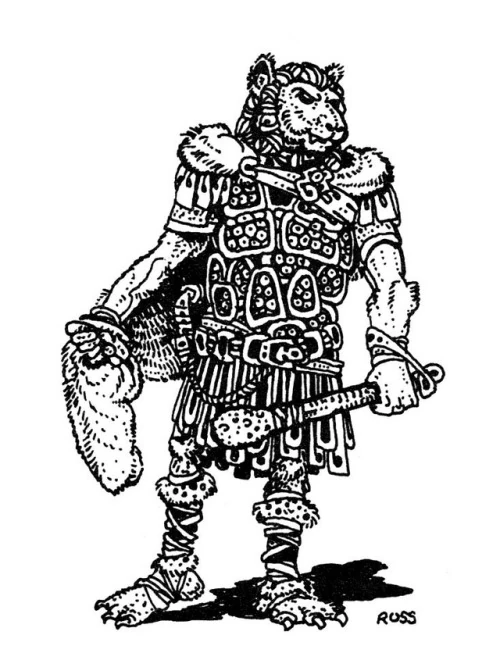

Gnolls
- 5.5E/5E: Medium Humanoid; Chaotic Evil; CR 9 (Flind), 1 (Flesh Carver), 1/2 (Hunter)
- 5.5E/5E: Medium Undead; Chaotic Evil; CR 1/4 (Witherling)
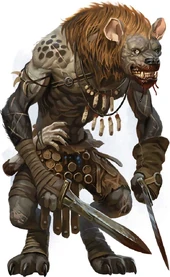 |
| Flesh Gnawer |
The second sub-type here is the Witherling, which is... well, an undead skeleton gnoll. Look at that gloriously grisly artwork! Witherlings are noted to be created when a gnoll band ends up being so hungry after a lack of prey that they turn on each other, and the losers whose flesh are consumed will have their bones collected and transformed by a gnoll's pack lord or flind leader into, well, Witherlings. Two other new variants are also noted here, the Gnoll Flesh Gnawer and the Gnoll Hunter, but they're basically gnolls who are more experienced at ranged weapons, stealth (the hunter) and dashing around (flesh gnawer). Generally 'race variants enemy' like these are kind of a necessary evil -- having a huge gnoll/goblin/lizardfolk/orc war camp but only having the same base "Gnoll" stat block for every enemy you face will get boring pretty quickly, and having enemies with varying abilities does liven things up a lot, and allows your DM to have quick elite enemies to throw at your party without having to go through the more tiresome conversion of, like, adding PC classes and whatnot. They just don't make for interesting conversation or discussion material. I do appreciate that we don't quite get as overboard as 4E's sentient monster variants do, though.
Giants:
All six of the classic giants get a 'buffed' leader version in Volo's, in addition to a whole load of lore about their creation and religion. I tended to, for the most part, shrug off these sort of variants when going through 3E and 4E's numerous bestiaries, the ones introduced here are actually pretty fun! Essentially taking the place of the "Titan" sub-type of giants in 4th Edition, these dudes are transformed into a more powerful state because of a godlike favour, or, like good ol' adventurers, they've gone off to seek other avenues of power.
- 5.5E/5E: Huge Giant; Chaotic Neutral; CR 11 (Cloud Giant Smiling One)
- 5.5E/5E: Huge Giant; Lawful Evil; CR 14 (Fire Giant Dreadnought)
- 5.5E/5E: Huge Beast; Chaotic Evil; CR 12 (Frost Giant Everlasting One)
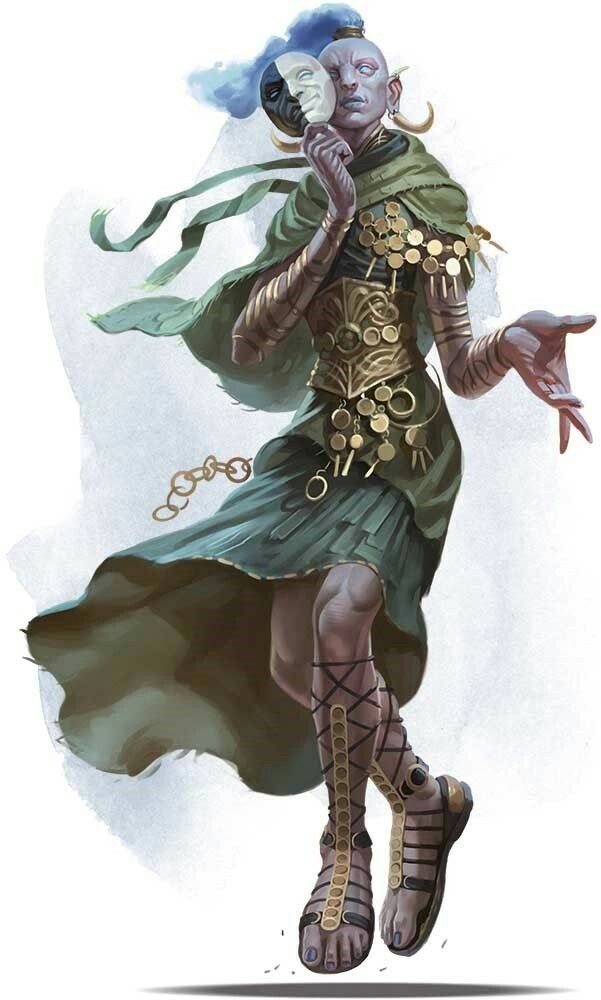

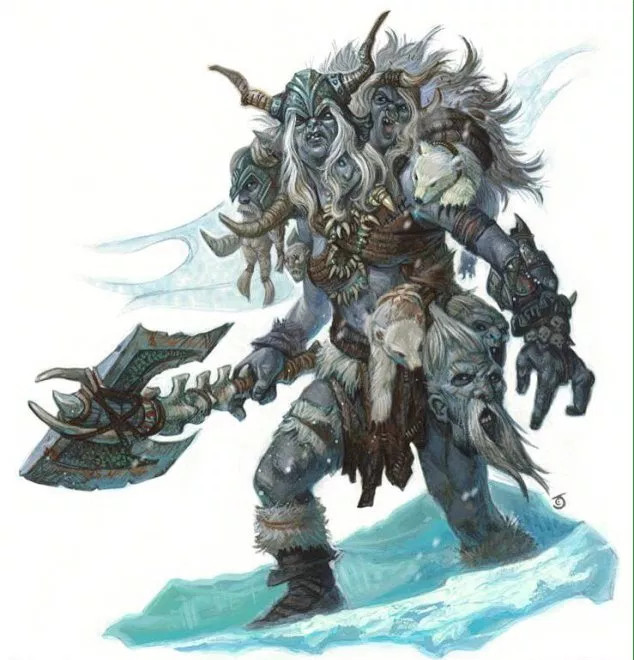
The first one we're talking about is the Cloud Giant Smiling One, which has a pretty simple but absolutely memorable artwork. It must be that theatre mask, which is kind of a somewhat easy way to instantly make a character design both cool and slightly unsettling, but it works, y'know? The Smiling Ones' lore is that they basically are social deviants for actually going through with their trickster god Memnor's craftiness and deceit, as opposed to the mostly 'tolerant of religion' cloud giant race as a whole. A pretty interesting variant, and based on the description of the mask, it seems that these Smiling Ones aren't happy that the Cloud Giants are second-best in the Ordning. Which might be interesting to play out in a giant-heavy campaign.
The Fire Giant Dreadnought is... she's just awesome, yeah? Full armour, two massive spiky shields, and generally looking like one hell of a literal tank. There's not much lore to her other than she basically embodies the two core parts of fire giant society -- war and forge-craft -- and it's a position that even the dumb-but-strong members among the fire giants can aspire to be. The freaking giant walking-wall shields actually have a mechanism that allows the fire giant to pour hot coal through them, making them a spiky fire shield. Absolutely metal. I actually liked the little blurb talking about the multi-purpose crazy plow-shield, which also has uses outside of combat to help shove around coal in forges and whatnot.
The Frost Giant Everlasting One is a worshiper of a god called Vaprak, who is a crazy troll god that giant religion frown upon. Those that embrace these crazy dreams become the frost giants' equivalent of warlocks, ending up going on a vision quest to meet and consume one of Vaprak's trolls, gaining the troll's regenerative ability at the price of being hobbled and cursed if they do not offer enough blood in Vaprak's name. At which point, all the other frost giants will exile or kill the Everlasting One. It's got a very awesome-looking artwork, too, with the frost giant lady's clothing being around 60% random disembodied heads. I didn't notice until a while and looking at the actual stat block that those heads on her shoulders are actually straight-up extra heads that grew out after Vaprak's blessing ended up mutating the frost giant. That's actually cool.
- 5.5E/5E: Huge Giant; Chaotic Evil; CR 6 (Mouth of Grolantor)
- 5.5E/5E: Huge Giant; Chaotic Neutral; CR 10 (Stone Giant Dreamwalker)
- 5.5E/5E: Huge Beast; Chaotic Good; CR 16 (Storm Giant Quintessent)
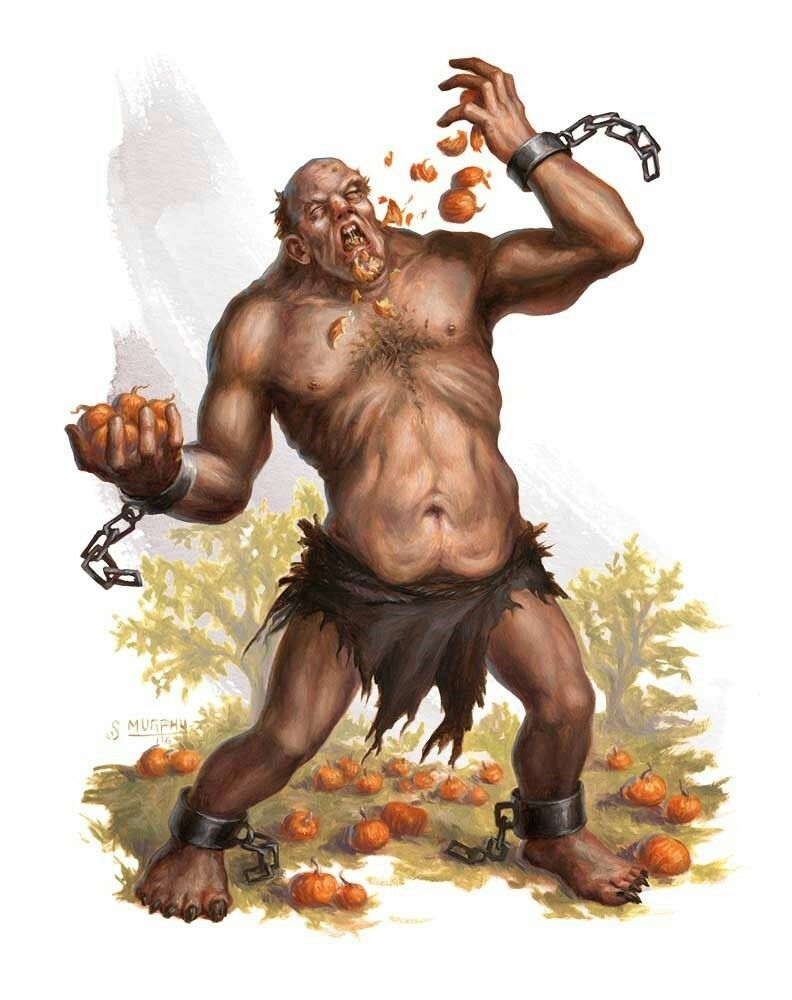

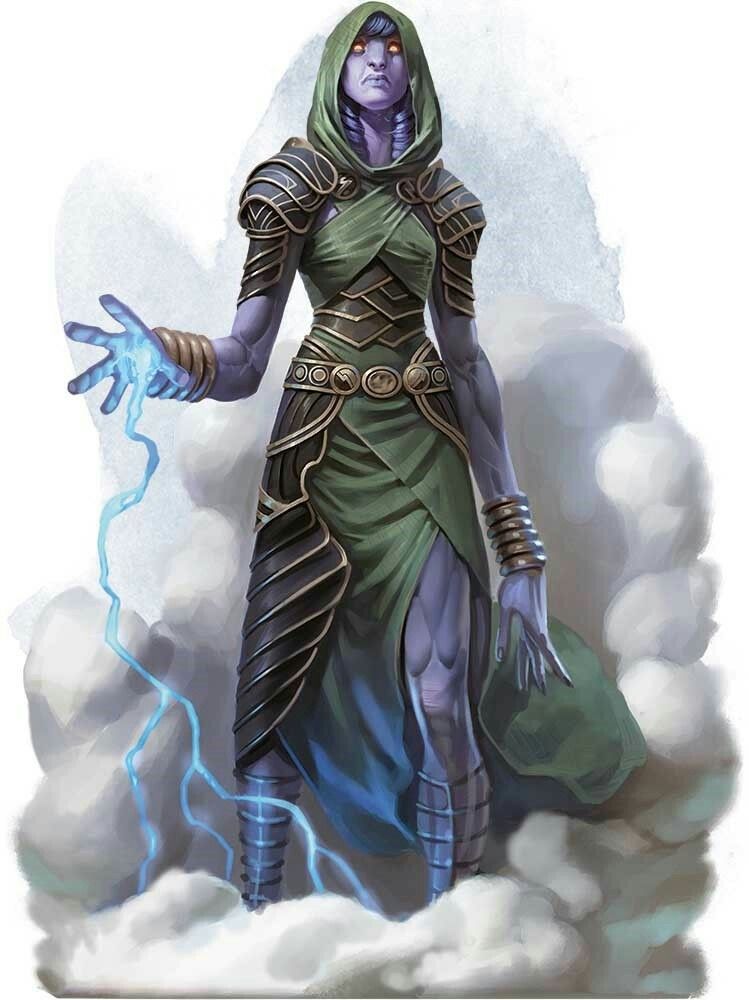
Hill giants are easily the most boring among the giantkin, and their 'super' mode, the Mouth of Grolantor, is... a sick hill giant that is exiled from their tribes, because, well, hill giants are supposed to be able to digest and eat anything. A hill giant that's sick and keeps vomiting? Clearly cursed. Although in a bizarre paradox, they also simultaneously become an embodiment of the hill giant god Grolantor's endless hunger. Okay...? And after being exiled, these Mouths of Grolantor end up being crazy and essentially is just a crazed, hungry big dude. A+ for whoever wrote the prose, but it's still easily still the most boring giant in this book. The Stone Giant Dreamwalker, likewise, isn't the most interesting one out there, although I do appreciate them taking more time in talking about the stone giants' "anything outside of mountains is a dream" bizarre mentality. These Dreamwalkers are either those who walk through 'dreams' (a.k.a. the outside world) in search for inspiration, visions, or simply exiled. And then they go mad and confused since the world is alien, and they sort of think that their actions have no real consequences. Okay? It's a neat variant of the base stone giant lore, but not especially interesting.
Last here is the Storm Giant Quintessent, who are storm giants who try to forestall their own deaths, essentially merging with storms and becoming a permanent, semi-conscious ball of stormy weather, although they can manifest their 'core' body somewhere within them. It's definitely an interesting, somewhat lich-like way, but one that feels uniquely tied into the Storm Giant's weather-related culture. Actually a pretty cool concept, if we're being honest, and certainly far cooler than the Hill and Stone Giants here.
The 5E stats for these creatures as they appear in Volo's Guide to Monsters.
- Banderhobb: Large monstrosity; neutral evil; CR 5
- Barghest: Large fiend - shapechanger; neutral evil; CR 4
- Death Kiss: Large aberration; neutral evil; CR 10
- Gauth: Medium aberration; lawful evil; CR 6
- Gazer: Tiny aberration; neutral evil; CR 1/2
- Bodak: Medium undead; chaotic evil; CR 6
- Boggle: Small fey; chaotic neutral; CR 1/8
- Catoblepas: Large monstrosity; unaligned; CR 5
- Cave Fisher: Medium monstrosity; unaligned; CR 3
- Chitine: Small monstrosity; chaotic evil; CR 1/2
- Choldrith: Medium monstrosity; chaotic evil; CR 3
- Cranium Rat: Tiny beast; lawful evil; CR 0
- Swarm of Cranium Rats: Medium swarm of tiny beasts; lawful evil; CR 5
- Darkling: Small fey; chaotic neutral; CR 1/2
- Darkling Elder: Medium fey; chaotic neutral; CR 2
- Deep Scion: Medium humanoid - shapechanger; neutral evil; CR 3
- Babau: Medium fiend - demon; chaotic evil; CR 4
- Maw Demon: Medium fiend - demon; chaotic evil; CR 1
- Shoosuva: Medium fiend - demon; chaotic evil; CR 8
- Devourer: Large fiend; chaotic evil; CR 13
- Dimetrodon: Medium beast; unaligned; CR 1/4
- Brontosaurus: Gargantuan beast; unaligned; CR 5
- Deinonychus: Medium beast; unaligned; CR 1
- Hadrosaurus: Large beast; unaligned; CR 1/4
- Quetzalcoatlus: Huge beast; unaligned; CR 2
- Stegosaurus: Huge beast; unaligned; CR 4
- Velociraptor: Tiny beast; unaligned; CR 1/4
- Draegloth: Large fiend - demon; chaotic evil; CR 7
- Firenewt Warrior: Medium humanoid - Firenewt; neutral evil; CR 1/2
- Giant Strider: Large monstrosity; neutral evil; CR 1
- Firenewt Warlock of Imix: Medium humanoid - Firenewt; neutral evil; CR 1
- Flail Snail: Large elemental; unaligned; CR 3
- Froghemoth: Huge monstrosity; unaligned; CR 10
- Cloud Giant Smiling One: Huge giant - cloud giant; chaotic neutral; CR 11
- Fire Giant Dreadnought: Huge giant - fire giant; lawful evil; CR 14
- Frost Giant Everlasting One: Huge giant - frost giant; chaotic evil; CR 12
- Mouth of Grolantor: Huge giant - hill giant; chaotic evil; CR 6
- Stone Giant Dreamwalker: Huge giant - stone giant; chaotic neutral; CR 10
- Storm Giant Quintessent: Huge giant - storm giant; chaotic good; CR 16
- Flind: Medium humanoid - gnoll; chaotic evil; CR 9
- Gnoll Flesh Carver: Medium humanoid - gnoll; chaotic evil; CR 1
- Gnoll Hunter: Medium humanoid - gnoll; chaotic evil; CR 1/2
- Gnoll Witherling: Medium undead; chaotic evil; CR 1/4
Deep Scion's mouth probably based off a Fringehead Fish
ReplyDeleteDang, I never knew a fish like that existed, but that sure is unmistakably the inspiration for the Deep Scion's mouth. It's amazing just how many weirdo fishies there are in the ocean, huh?
DeleteFor real.
Delete